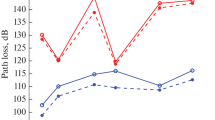Abstract
The 5G technology is characterized by the use of high frequency band corresponding to millimeter waves, these latter are highly sensitive to the propagation environment and the atmospheric conditions. Thus, for proper planning of future 5G radio network it is necessary to have a reliable tool that can predict the behavior of mm-waves in a particular environment and under some specific climate conditions. This article focuses on the study of the Close in Free (CI) model, a model that combines those two aspects of study. Indeed the CI model introduces an atmospheric attenuations term which is rarely taken into account and considered in the existing 5G channel models. This channel model is integrated in 5G radio planning tool called NYUSIM, which is developed by NYU WIRELESS research group at New York University (NYU). Nevertheless, we found some difficulties and limitations on this software that we tried to resolve, by designing a new tool which will give more information about the radio part of 5G network. The new software is designed in Research laboratory in Telecommunication Systems, Networks and Services (STRS) of the National institute of posts and telecommunications (INPT) in Morocco.
Access this chapter
Tax calculation will be finalised at checkout
Purchases are for personal use only
Similar content being viewed by others
References
Sun, S.: NYUSIM User Manual. New York University, New York (2017)
Poutanen, J.: Geometry-Based Radio Channel Modeling: Propagation Analysis and Concept Development. Aalto University, Espoo (2011)
Samimi, M.K., Rappaport, T.S.: 3-D millimeter-wave statistical channel model for 5G wireless system design. IEEE Trans. Microw. Theory Tech. 64, 2207–2225 (2016)
Sun, S., Maccartney, G.R., Rappaport, T.S.: A novel millimeter-wave channel simulator and applications for 5G wireless communications. In: 2017 IEEE International Conference on Communications (ICC) (2017)
3GPP: Study on channel model for frequencies from 0.5 to 100 GHz. In: 3rd Generation Partnership Project (3GPP) (2017)
Rappaport, T.S., Sun, S., Shafi, M.: Investigation and comparison of 3GPP and NYUSIM channel models for 5G wireless communications. In: 2017 IEEE 86th Vehicular Technology Conference (VTC-Fall) (2017)
Liebe, H.J., Hufford, G.A., Cotton, M.G.: Propagation modeling of moist air and suspended water/ice particles at frequencies below 1000 GHz. In: AGARD Conference on Proceedings, Spain (1993)
Lagrange, X., Godlewski, P., Tabbane, S.: Rèseaux GSM. Hermès Science Publications, Paris (2000)
Hakam, A., Shubair, R.M., Salahat, E.: Enhanced DOA estimation algorithms using MVDR and MUSIC. In: 2013 International Conference on Current Trends in Information Technology (CTIT) (2013)
WeatherSpark.com: Weather spark (2017). https://fr.weatherspark.com/
Martin, L.: Conception d’une Antenne Compacte de Station de Base pour Réseaux Cellulaires. Nantes University, Nantes (2017)
Bas, C.U., Wang, R., Choi, T., Hur, S., Whang, K., Park, J., Zhang, J., Molisch, A.F.: Outdoor to indoor penetration loss at 28 GHz for fixed wireless access. In: 2018 IEEE International Conference on Communications (ICC) (2018). https://doi.org/10.1109/icc.2018.8422819
Jain, I.: Millimeter Wave Line-of-Sight Blockage Analysis. New York University, New York (2018)
Tokay, A., Bashor, P., Habib, E., Kasparis, T.: Raindrop size distribution measurements in tropical cyclones. Mon. Weather Rev. 136, 1669–1685 (2008)
Author information
Authors and Affiliations
Corresponding authors
Editor information
Editors and Affiliations
Rights and permissions
Copyright information
© 2020 Springer Nature Switzerland AG
About this paper
Cite this paper
Squali, L., Aloh, J.C., Riouch, F. (2020). New Tool for 5G Radio Network Planning and Deployment. In: Ben Ahmed, M., Boudhir, A., Santos, D., El Aroussi, M., Karas, İ. (eds) Innovations in Smart Cities Applications Edition 3. SCA 2019. Lecture Notes in Intelligent Transportation and Infrastructure. Springer, Cham. https://doi.org/10.1007/978-3-030-37629-1_46
Download citation
DOI: https://doi.org/10.1007/978-3-030-37629-1_46
Published:
Publisher Name: Springer, Cham
Print ISBN: 978-3-030-37628-4
Online ISBN: 978-3-030-37629-1
eBook Packages: EngineeringEngineering (R0)




